Deepfake technology, powered by artificial intelligence (AI), has emerged as a groundbreaking innovation in the realm of digital media. By creating hyper-realistic images, videos, and audio that can mimic real people, deepfakes have the potential to revolutionize various industries. However, this technology also raises significant ethical and security concerns.
How Deepfakes Are Created
Deepfakes are primarily generated using deep learning techniques, such as variational autoencoders (VAEs) and generative adversarial networks (GANs). VAEs help in encoding and decoding data, while GANs consist of two neural networks—the generator and the discriminator—that work together to produce realistic content. The generator creates fake media, and the discriminator evaluates its authenticity, leading to continuous improvement in the quality of the generated content.
Applications of Deepfake Technology
Deepfake technology has found applications in several fields:
- Entertainment: In movies and television, deepfakes can be used to create realistic special effects or bring deceased actors back to life on screen. For example, deepfake technology was used to recreate a young Luke Skywalker in “The Mandalorian”.
- Education: Deepfakes can enhance educational content by creating engaging and interactive learning experiences. For instance, historical figures can be brought to life to deliver lectures or speeches.
- Marketing: Brands can use deepfakes to create personalized advertisements and promotional content. Dove’s “Toxic Advice” campaign used deepfake technology to highlight harmful beauty advice.
Risks and Ethical Concerns
Despite its positive applications, deepfake technology poses several risks:
- Misinformation: Deepfakes can be used to spread false information, manipulate public opinion, and create fake news. A notable example is the deepfake video of Ukrainian President Volodymyr Zelenskyy appearing to call for his troops to surrender during the Russia-Ukraine conflict.
- Fraud: Hyper-realistic deepfakes can be employed in identity theft and financial scams. In one case, a deepfake audio was used to scam a CEO out of $243,000 by mimicking the voice of his boss.
- Privacy Violations: Deepfakes can infringe on individuals’ privacy by creating unauthorized and misleading representations. The deepfake Tom Cruise videos on TikTok are a popular example of how realistic and convincing these creations can be.
Detection and Countermeasures
To combat the negative impacts of deepfakes, researchers are developing AI-based tools and techniques to detect and mitigate their effects. These include analyzing inconsistencies in facial movements, lip-syncing errors, and lighting anomalies. Additionally, educating the public about the existence and risks of deepfakes is crucial in fostering a more informed and vigilant society.
Conclusion
Deepfake technology represents a significant advancement in AI and digital media, offering both exciting possibilities and serious challenges. As we continue to explore its potential, it is essential to address the ethical and security concerns associated with deepfakes to ensure their responsible use. By balancing innovation with caution, we can harness the power of deepfake technology while safeguarding against its misuse.
We hope the above information provides a comprehensive overview of deepfake technology. If you need further details or have specific questions, feel free to ask!

